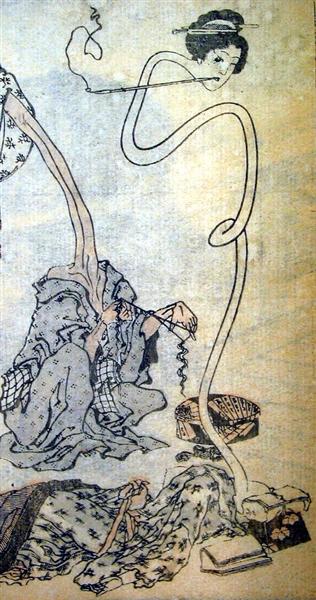説明
北野katsushikaの作品「rokurokubi」は、江戸時代(1603-1868)に栄えた日本のスタイルである裕子文化の豊かな文脈の一部です。この時代で最も有名な芸術家の一人である北朝鮮は、木材の印象を作成する習熟と、日常生活、日本の性質、神話を捉えた絵画で有名です。 「Rokurokubi」は、日本の民間伝承の伝説や生き物、特に夜中に首を伸ばす能力を持つヨカイの姿にforります。
この絵で際立っている最初の側面は、女性の主人公から発せられる不穏でほとんど夢のような表現です。中央の人物である女性には、注意を引く謎めいた表情が提示されています。彼の目は、ほとんど超自然的な輝きで、シーンの静けさとは対照的な深さと活力を示唆しています。鮮やかな色の着物を着ている女性は、作品の独特で邪魔な要素になる細長い首で、作曲の焦点です。北朝鮮は、空間の視点と扱いをして、この伸びを強調するために演じます。同時に、敬意を表し、日本の肖像画の慣習に挑戦するリソースです。
北朝鮮によって選ばれたカラーパレットは、豊かで多様であり、赤、青、緑のトーンを使用して、作品に深さとテクスチャの感覚を提供します。それぞれの色は、女性の服を説明するだけでなく、感情的な状態と超自然の雰囲気を反映しています。影の微妙さと着物の上に光が分散する方法は、動きの捕獲と光の過渡性である馬の領域を意味します。
構成内の要素の配置は、視聴者が人物とその周囲の関係を探求するように誘う視覚的な緊張を生み出します。基金には抽象的な風景があり、それは主なアプローチではありませんが、非現実感で数字を補完します。この人間と超自然的な融合は、日本文化におけるヨカイの本質、社会に共鳴する恐怖と迷信の象徴を反映しています。
神話の生き物としてのンスロクビは、北海の問題と人間の存在の二重性の探求に対する北村の関心を再確認します。彼女の細長い首を持つ女性のイメージは、不気味の象徴であるだけでなく、身体的限界の解放の表現として解釈することもできます。正常および異常の観客の。
「Rokurokubi」は、最終的には、日本の民間伝承の本質を捉えた星南の領域の証言であり、超自然と日常を絡み合う能力です。この作品は、夜の時間の暗闇の中で、現実とファンタジーが彼らの道を越え、想像力と伝統が見つかった世界に窓を提供できることを思い出させるものとして機能します。この絵画は、北海の天才の例であるだけでなく、豊かな日本文化を織り込んだアイデンティティ、知覚、伝説の意味を反映する作品でもあります。
KUADROS ©、あなたの壁に有名な絵の具。
プロのアーティストの品質と独特の印章を備えた手作りの油絵 KUADROS ©.
満足度保証付きの写真複製サービス。絵画のレプリカに完全に満足していない場合は、100%のお金を返金します。

